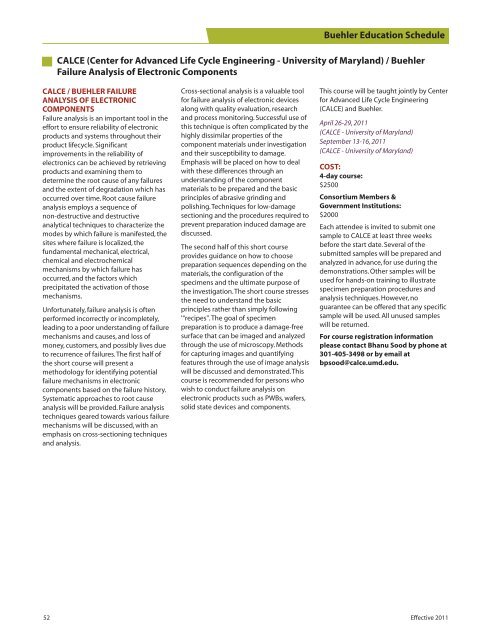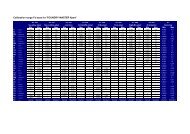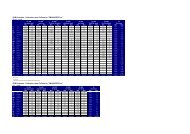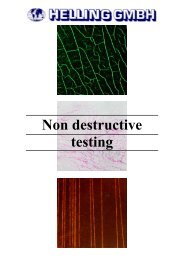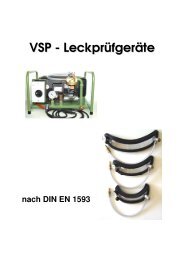Your Partner for Consumables in Materials Preparation Buehler ...
Your Partner for Consumables in Materials Preparation Buehler ...
Your Partner for Consumables in Materials Preparation Buehler ...
You also want an ePaper? Increase the reach of your titles
YUMPU automatically turns print PDFs into web optimized ePapers that Google loves.
<strong>Buehler</strong> Education Schedule<br />
CALCE (Center <strong>for</strong> Advanced Life Cycle Eng<strong>in</strong>eer<strong>in</strong>g - University of Maryland) / <strong>Buehler</strong><br />
Failure Analysis of Electronic Components<br />
CALCE / BUEHLER FAILURE<br />
ANALYSIS OF ELECTRONIC<br />
COMPONENTS<br />
Failure analysis is an important tool <strong>in</strong> the<br />
ef<strong>for</strong>t to ensure reliability of electronic<br />
products and systems throughout their<br />
product lifecycle. Significant<br />
improvements <strong>in</strong> the reliability of<br />
electronics can be achieved by retriev<strong>in</strong>g<br />
products and exam<strong>in</strong><strong>in</strong>g them to<br />
determ<strong>in</strong>e the root cause of any failures<br />
and the extent of degradation which has<br />
occurred over time. Root cause failure<br />
analysis employs a sequence of<br />
non-destructive and destructive<br />
analytical techniques to characterize the<br />
modes by which failure is manifested, the<br />
sites where failure is localized, the<br />
fundamental mechanical, electrical,<br />
chemical and electrochemical<br />
mechanisms by which failure has<br />
occurred, and the factors which<br />
precipitated the activation of those<br />
mechanisms.<br />
Un<strong>for</strong>tunately, failure analysis is often<br />
per<strong>for</strong>med <strong>in</strong>correctly or <strong>in</strong>completely,<br />
lead<strong>in</strong>g to a poor understand<strong>in</strong>g of failure<br />
mechanisms and causes, and loss of<br />
money, customers, and possibly lives due<br />
to recurrence of failures. The first half of<br />
the short course will present a<br />
methodology <strong>for</strong> identify<strong>in</strong>g potential<br />
failure mechanisms <strong>in</strong> electronic<br />
components based on the failure history.<br />
Systematic approaches to root cause<br />
analysis will be provided. Failure analysis<br />
techniques geared towards various failure<br />
mechanisms will be discussed, with an<br />
emphasis on cross-section<strong>in</strong>g techniques<br />
and analysis.<br />
Cross-sectional analysis is a valuable tool<br />
<strong>for</strong> failure analysis of electronic devices<br />
along with quality evaluation, research<br />
and process monitor<strong>in</strong>g. Successful use of<br />
this technique is often complicated by the<br />
highly dissimilar properties of the<br />
component materials under <strong>in</strong>vestigation<br />
and their susceptibility to damage.<br />
Emphasis will be placed on how to deal<br />
with these differences through an<br />
understand<strong>in</strong>g of the component<br />
materials to be prepared and the basic<br />
pr<strong>in</strong>ciples of abrasive gr<strong>in</strong>d<strong>in</strong>g and<br />
polish<strong>in</strong>g. Techniques <strong>for</strong> low-damage<br />
section<strong>in</strong>g and the procedures required to<br />
prevent preparation <strong>in</strong>duced damage are<br />
discussed.<br />
The second half of this short course<br />
provides guidance on how to choose<br />
preparation sequences depend<strong>in</strong>g on the<br />
materials, the configuration of the<br />
specimens and the ultimate purpose of<br />
the <strong>in</strong>vestigation. The short course stresses<br />
the need to understand the basic<br />
pr<strong>in</strong>ciples rather than simply follow<strong>in</strong>g<br />
'“recipes". The goal of specimen<br />
preparation is to produce a damage-free<br />
surface that can be imaged and analyzed<br />
through the use of microscopy. Methods<br />
<strong>for</strong> captur<strong>in</strong>g images and quantify<strong>in</strong>g<br />
features through the use of image analysis<br />
will be discussed and demonstrated. This<br />
course is recommended <strong>for</strong> persons who<br />
wish to conduct failure analysis on<br />
electronic products such as PWBs, wafers,<br />
solid state devices and components.<br />
This course will be taught jo<strong>in</strong>tly by Center<br />
<strong>for</strong> Advanced Life Cycle Eng<strong>in</strong>eer<strong>in</strong>g<br />
(CALCE) and <strong>Buehler</strong>.<br />
April 26-29, 2011<br />
(CALCE - University of Maryland)<br />
September 13-16, 2011<br />
(CALCE - University of Maryland)<br />
COST:<br />
4-day course:<br />
$2500<br />
Consortium Members &<br />
Government Institutions:<br />
$2000<br />
Each attendee is <strong>in</strong>vited to submit one<br />
sample to CALCE at least three weeks<br />
be<strong>for</strong>e the start date. Several of the<br />
submitted samples will be prepared and<br />
analyzed <strong>in</strong> advance, <strong>for</strong> use dur<strong>in</strong>g the<br />
demonstrations. Other samples will be<br />
used <strong>for</strong> hands-on tra<strong>in</strong><strong>in</strong>g to illustrate<br />
specimen preparation procedures and<br />
analysis techniques. However, no<br />
guarantee can be offered that any specific<br />
sample will be used. All unused samples<br />
will be returned.<br />
For course registration <strong>in</strong><strong>for</strong>mation<br />
please contact Bhanu Sood by phone at<br />
301-405-3498 or by email at<br />
bpsood@calce.umd.edu.<br />
52 Effective 2011


